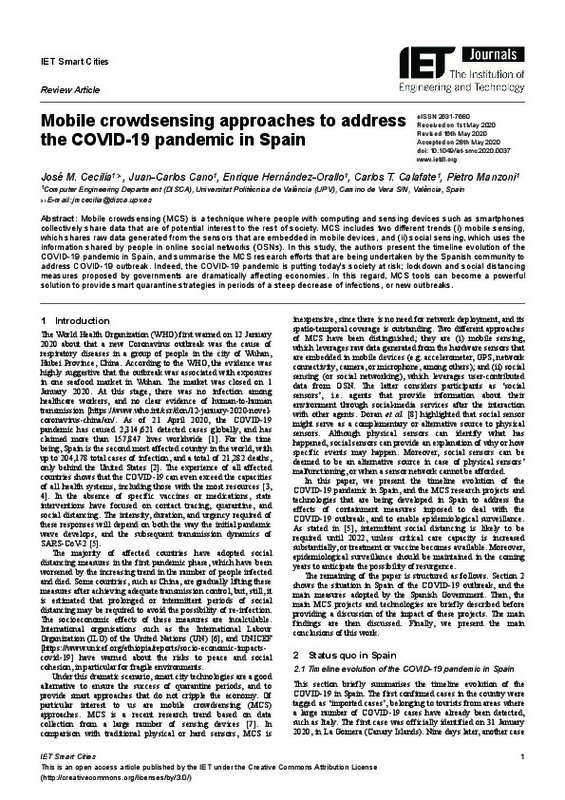JavaScript is disabled for your browser. Some features of this site may not work without it.
Buscar en RiuNet
Listar
Mi cuenta
Estadísticas
Ayuda RiuNet
Admin. UPV
Mobile crowdsensing approaches to address the COVID-19 pandemic in Spain
Mostrar el registro sencillo del ítem
Ficheros en el ítem
| dc.contributor.author | Cecilia-Canales, José María
|
es_ES |
| dc.contributor.author | Cano, Juan-Carlos
|
es_ES |
| dc.contributor.author | Hernández-Orallo, Enrique
|
es_ES |
| dc.contributor.author | Tavares De Araujo Cesariny Calafate, Carlos Miguel
|
es_ES |
| dc.contributor.author | Manzoni, Pietro
|
es_ES |
| dc.date.accessioned | 2021-03-10T04:31:37Z | |
| dc.date.available | 2021-03-10T04:31:37Z | |
| dc.date.issued | 2020-07 | es_ES |
| dc.identifier.uri | http://hdl.handle.net/10251/163587 | |
| dc.description.abstract | [EN] Mobile crowdsensing (MCS) is a technique where people with computing and sensing devices such as smartphones collectively share data that are of potential interest to the rest of society. MCS includes two different trends (i) mobile sensing, which shares raw data generated from the sensors that are embedded in mobile devices, and (ii) social sensing, which uses the information shared by people in online social networks (OSNs). In this study, the authors present the timeline evolution of the COVID¿19 pandemic in Spain, and summarise the MCS research efforts that are being undertaken by the Spanish community to address COVID¿19 outbreak. Indeed, the COVID¿19 pandemic is putting today's society at risk; lockdown and social distancing measures proposed by governments are dramatically affecting economies. In this regard, MCS tools can become a powerful solution to provide smart quarantine strategies in periods of a steep decrease of infections, or new outbreaks. | es_ES |
| dc.description.sponsorship | This work was partially supported by the Fundación Séneca del Centro de Coordinación de la Investigación de la Región de Murcia under Project 20813/PI/18, and by the Spanish Ministry of Science, Innovation and Universities under grants RTI2018-096384-B-I00 and RTC-2017-6389-5. | es_ES |
| dc.language | Inglés | es_ES |
| dc.publisher | Institution of Engineering and Technology | es_ES |
| dc.relation.ispartof | IET Smart Cities | es_ES |
| dc.rights | Reconocimiento (by) | es_ES |
| dc.subject.classification | ARQUITECTURA Y TECNOLOGIA DE COMPUTADORES | es_ES |
| dc.title | Mobile crowdsensing approaches to address the COVID-19 pandemic in Spain | es_ES |
| dc.type | Artículo | es_ES |
| dc.identifier.doi | 10.1049/iet-smc.2020.0037 | es_ES |
| dc.relation.projectID | info:eu-repo/grantAgreement/f SéNeCa//20813%2FPI%2F18/ | es_ES |
| dc.relation.projectID | info:eu-repo/grantAgreement/AEI//RTC-2017-6389-5/ES/PLANIFICACIÓN Y GESTIÓN DE RECURSOS HÍDRICOS A PARTIR DE ANÁLISIS DE DATOS DE IoT (WATERoT)/ | es_ES |
| dc.relation.projectID | info:eu-repo/grantAgreement/AEI/Plan Estatal de Investigación Científica y Técnica y de Innovación 2017-2020/RTI2018-096384-B-I00/ES/SOLUCIONES PARA UNA GESTION EFICIENTE DEL TRAFICO VEHICULAR BASADAS EN SISTEMAS Y SERVICIOS EN RED/ | es_ES |
| dc.relation.projectID | info:eu-repo/grantAgreement/AEI//RYC-2018-025580-I/ | es_ES |
| dc.rights.accessRights | Abierto | es_ES |
| dc.contributor.affiliation | Universitat Politècnica de València. Departamento de Informática de Sistemas y Computadores - Departament d'Informàtica de Sistemes i Computadors | es_ES |
| dc.description.bibliographicCitation | Cecilia-Canales, JM.; Cano, J.; Hernández-Orallo, E.; Tavares De Araujo Cesariny Calafate, CM.; Manzoni, P. (2020). Mobile crowdsensing approaches to address the COVID-19 pandemic in Spain. IET Smart Cities. 2(2):1-6. https://doi.org/10.1049/iet-smc.2020.0037 | es_ES |
| dc.description.accrualMethod | S | es_ES |
| dc.relation.publisherversion | https://doi.org/10.1049/iet-smc.2020.0037 | es_ES |
| dc.description.upvformatpinicio | 1 | es_ES |
| dc.description.upvformatpfin | 6 | es_ES |
| dc.type.version | info:eu-repo/semantics/publishedVersion | es_ES |
| dc.description.volume | 2 | es_ES |
| dc.description.issue | 2 | es_ES |
| dc.identifier.eissn | 2631-7680 | es_ES |
| dc.relation.pasarela | S\425205 | es_ES |
| dc.contributor.funder | Agencia Estatal de Investigación | es_ES |
| dc.contributor.funder | Fundación Séneca-Agencia de Ciencia y Tecnología de la Región de Murcia | es_ES |
| dc.description.references | World Health Organization:‘Novel coronavirus (2019‐ncov): Situation report 91’ [accessed 30‐April‐2020] | es_ES |
| dc.description.references | Instituto de Salud.Carlos.III:‘Situación de covid‐19 en españa’ [accessed 30‐April‐2020].https://covid19.isciii.es/ | es_ES |
| dc.description.references | LiR.RiversC.TanQ.et al.: ‘The demand for inpatient and ICU beds for COVID‐19 in the US: lessons from Chinese cities’ medRxiv 2020 pp.1–12 doi:10.1101/2020.03.09.20033241 | es_ES |
| dc.description.references | World Health Organization:‘Critical preparedness readiness and response actions for COVID‐19: interim guidance 22 March 2020’ | es_ES |
| dc.description.references | Kissler, S. M., Tedijanto, C., Goldstein, E., Grad, Y. H., & Lipsitch, M. (2020). Projecting the transmission dynamics of SARS-CoV-2 through the postpandemic period. Science, 368(6493), 860-868. doi:10.1126/science.abb5793 | es_ES |
| dc.description.references | International Labour Organization: ‘The socioeconomic impact of COVID‐19 in fragile settings: peace and social cohesion at risk’ https://www.ilo.org/global/topics/employment‐promotion/recovery‐and‐reconstruction/WCMS_741158/langen/index.htm [accessed 30‐April‐2020] | es_ES |
| dc.description.references | Guo, B., Wang, Z., Yu, Z., Wang, Y., Yen, N. Y., Huang, R., & Zhou, X. (2015). Mobile Crowd Sensing and Computing. ACM Computing Surveys, 48(1), 1-31. doi:10.1145/2794400 | es_ES |
| dc.description.references | AdolphC.AmanoK.Bang JensenB.et al.: ‘Pandemic politics: timing state‐level social distancing responses to COVID‐19’ medRxiv 2020 | es_ES |








